On
occasion, I will take aspiring RC pilots under my wing and pass
along the skills I have learned in flying radio controlled aircraft.
Equipment
The
following is the basic equipment that is needed for a person to
get into a radio controlled aircraft,
•
First of all, a good radio controlled trainer aircraft. I would highly recommend beginning with a gas airplane, not an electric.
It is much easier to learn with gas and then move to electrics if
that is what you would like to do. Electrics are getting better all the time and are becoming much more desirable. Their flight dynamics are improving all the time but I would still recommend a gas powered plane to learn on. Lately, I have been recommending
the Alpha Trainer by Hanger 9. This is one of the best trainers
I have ever flown. It is inexpensive and uses an inexpensive .40
sized engine. The Alpha comes as an ARF (Almost Ready to Fly). It
is fully covered. The builder must install the engine and radio
components. He must also glue the wings together and glue the tail
surfaces on. This can easily be accomplished in one evening.
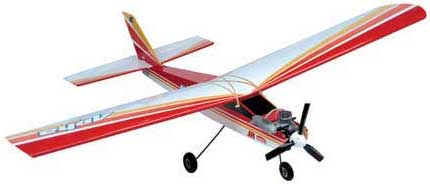 |
| Hangar 9's Alpha Trainer is one of the best trainers on the market in my opinion. This is a photo of the older version. The newer version should be just as good if not even better. If you can't learn to fly this airplane, you might as well give up trying! |
• A
Four Channel Radio. I
would highly recommend purchasing a computerized 2.4 ghz radio control system
for your airplane although this is not necessary. The newer computerized
systems allow the pilot to fly several aircraft with only one transmitter.
The 2.4 ghz simplifies frequency problems. With the older radio systems, you must make sure no one else is flying on your frequency. The newer 2.4 ghz systems eliminate this problem. It won't be long until every radio control pilot will only use the 2.4 ghz system.
You can get a good radio
control system that is not computerized at very low costs. It is
usually better to stay with the most popular brand names such as
JR or Futaba. For your trainer you will need four channels that
will control the throttle, rudder, elevator and ailerons. The system
you will need will have a transmitter, a receiver, a receiver battery
pack and four servos. Four channels is just the minimum that is
required. Many RC pilots decide to purchase a radio with more channels,
such as 5, 6, 9 channels or even more. More channels will allow
you to add more features to your current airplane or a future airplane.
Extra features such as flaps, bomb drop, retractable landing gear
all require more channels. Never purchase any radio with less than
four channels.
•
Engine. Most
new pilots begin with the economical .40 sized engine for their
trainer. An inexpensive .40 sized engine will fly the Alpha trainer
with no problems. Some people choose to go with a more powerful
.46 sized engine but this is absolutely not necessary and the expense
is over double that of a .40 engine.
•
Other Accessories. If you purchase an ARF (Almost Ready
to Fly) airplane, it will come with all of the necessary hardware,
wheels and fuel tank. Other things that you will have to have are fuel, fuel pump and a glow plug igniter. Other things that are not necessary but will sure make your life
much easier are, an electric starter, a flght box to
carry all of your tools, a glow plug wrench and a twelve volt battery
Below you will see the absolute minimum you need in accessories:
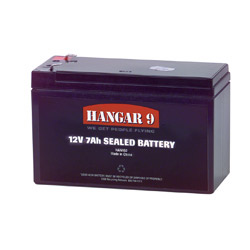 |
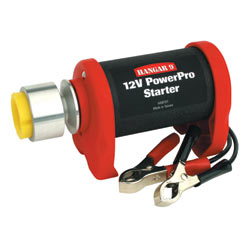 |
| A small 12 volt battery is used to power an electric starter for your airplane. They cost around $20 at your local hobby shop. |
This is a typical electric starter. These things will simplify your life and are worth every penny. I have used the Sullivan brand for years and have never had a problem with it. Just clip it on your 12 volt battery and it is ready to go. |
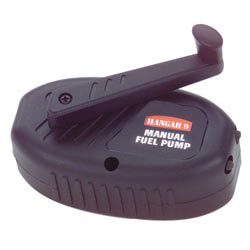 |
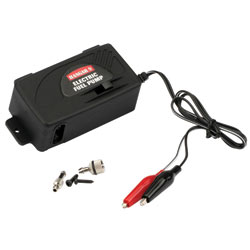 |
| This is a manual fuel pump. With it you can fuel your airplane and remove the fuel when it is time to take your airplane home. |
For almost the same price as a manual fuel pump you can get an electric pump. I definitely prefer the electric one. Just clip it onto your 12 volt battery and fuel your plane or remove the fuel. |
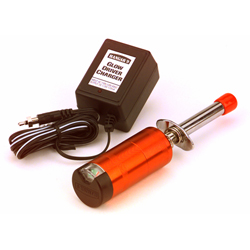 |
| This is the one accessory you must have. The glow plug ignitor clips onto the engine's glow plug so that the engine will start. Without this you will never get your engine started. Use the handy charger to keep the battery charged. |
A Word About Glow Fuel
You must have glow fuel for your airplane engine to run. DO NOT try to use gasoline or any other fuel in your glow engine. When you go to your hobby shop you will see a variety of fuels available to you. Normally, the fuel will be in plastic gallon jugs with varying levels of nitro. Nitro is nitromethane. It is an alcohol that is used in your glow engine. It is mixed with castor oil or synthetic oil. You will probably see mixes of 10% and up and the guy at the hobby shop will probably recommend the 10% fuel. The more nitro that is in the fuel, the more money you are going to pay for it. Here is a little secret that I found that has saved me a lot of money over the years. First of all, glow fuel is not cheap so look for "FAI" fuel. If your hobby shop doesn't have it, have them order you some. FAI fuel is used in almost all radio controlled aerobatic competitions in Europe and it contains no nitro. Your airplane will fly just as well on FAI fuel as it will on the other fuels. If you don't believe me, buy a gallon of each and do the comparisons. The only time you would need the higher nitro fuels are in helicopters and in ducted fan aircraft where you are trying to squeeze all the rpm's you can get out of an engine. Trust me on this and save yourself some money!
Propeller Safety
Model
airplane propellers are EXTREMELY DANGEROUS!!! I
just recently got my thumb and three fingers on my right hand in
a student's propeller. The damage required approximately twenty-five
stitches in my thumb. I let myself get distracted while setting
the needle valve on the student's plane. People have lost fingers
by getting them in a prop. DON'T let it be you!!!
When
using a carbon filled propeller, ALWAYS scrape the front and back
of each blade with a pocket knife to dull the blades. The molding
process of these props causes the edges to be razor sharp.
I
just purchased a pair of Kevlar gloves. They are a soft cloth that
will allow me to make changes on the needle valve without the danger
of having a finger cut off. The prop could still break my fingers
but the Kevlar will give me a better chance of not being cut so
badly.
NEXT
- FLYING LESSONS |
